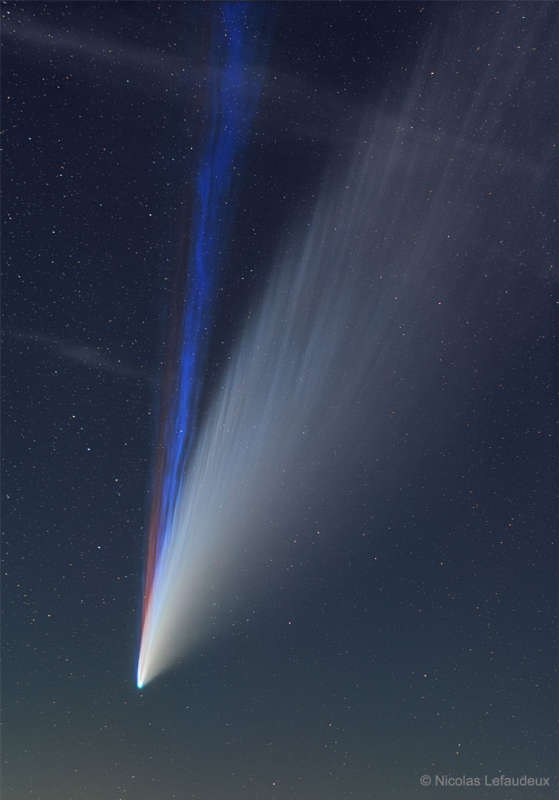
|
Credit & Copyright: Nicolas Lefaudeux
Explanation:
What created the unusual red tail in Comet NEOWISE?
Sodium.
A spectacular sight back in the summer of 2020, Comet NEOWISE,
at times, displayed something more than just a
surprisingly
striated
white dust tail and a
pleasingly patchy blue
ion tail.
Some color sensitive
images showed an unusual red tail, and
analysis showed much of this third tail's color was emitted by sodium.
Gas rich in sodium atoms might have been liberated from
Comet NEOWISE's warming nucleus in early July by bright
sunlight, electrically charged by
ultraviolet sunlight, and then pushed out by the
solar wind.
The
featured image
was captured in mid-July from
Brittany,
France
and shows the real colors.
Sodium comet tails have been seen before but are
rare --
this one disappeared by late July.
Comet C/2020 F3 (NEOWISE)
has since faded,
lost all of its bright tails, and now approaches the orbit of
Jupiter
as it heads back to the outer
Solar System, to return only in about 7,000 years.
Astrophysicists:
Browse 2,400+ codes in the Astrophysics Source Code Library
|
January February March April May June July August September October November December |
| ||||||||||||||||||||||||||||||||||||||||||||||||
NASA Web Site Statements, Warnings, and Disclaimers
NASA Official: Jay Norris. Specific rights apply.
A service of: LHEA at NASA / GSFC
& Michigan Tech. U.
Based on Astronomy Picture
Of the Day
Publications with keywords: comet
Publications with words: comet
See also:
- APOD: 2025 November 25 Á Comet Lemmon and the Milky Way
- 3I/ATLAS: A View from Planet Earth
- APOD: 2025 November 17 Á Comet Lemmons Wandering Tail
- APOD: 2025 September 30 Á Comet Lemmon Brightens
- APOD: 2025 September 29 Á Two Camera Comets in One Sky
- APOD: 2025 September 26 Á A SWAN an ATLAS and Mars
- APOD: 2025 September 18 Á Comet C/2025 R2 SWAN
